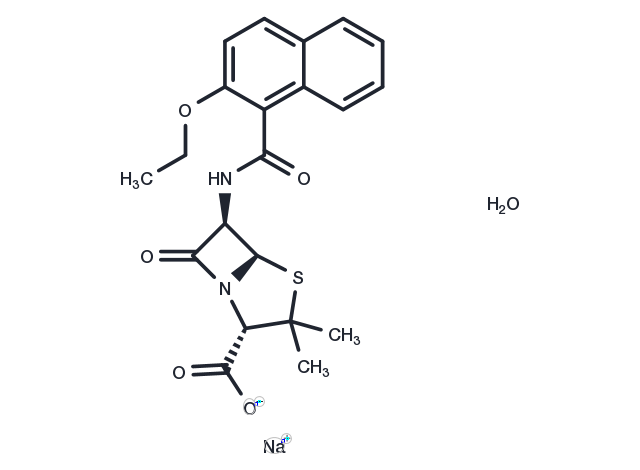Powder: -20°C for 3 years | In solvent: -80°C for 1 year


Nafcillin sodium monohydrate (CL 8491) is the sodium salt form of nafcillin, a semi-synthetic naphthalene, penicillin-related Nafcillin inhibits bacterial wall synthesis by a mechanism of action similar to penicillin. Penicillinase-resistant Nafcillin is used to treat infections caused by penicillin-resistant strains of Staphylococci.

| Pack Size | Availability | Price/USD | Quantity |
|---|---|---|---|
| 50 mg | In stock | $ 30.00 |





| Description | Nafcillin sodium monohydrate (CL 8491) is the sodium salt form of nafcillin, a semi-synthetic naphthalene, penicillin-related Nafcillin inhibits bacterial wall synthesis by a mechanism of action similar to penicillin. Penicillinase-resistant Nafcillin is used to treat infections caused by penicillin-resistant strains of Staphylococci. |
| Targets&IC50 | β-lactamase:33 mM(Kd) |
| In vivo | Nafcillin sodium inactivates beta-lactamase by forming a covalent acyl-enzyme intermediate with Ser-70. At concentrations greater than 80 mM, and exposure times less than 200 seconds, Nafcillin completely inhibits the activity of beta-lactamase. Upon removal of Nafcillin, the inhibited enzyme can be fully reactivated with a rate constant of 2×10^-3/s at 25°C. |
| Synonyms | CL 8491, nafcillin sodium |
| Molecular Weight | 454.47 |
| Formula | C21H21N2O5SNa·H2O |
| CAS No. | 7177-50-6 |
Powder: -20°C for 3 years | In solvent: -80°C for 1 year
Ethanol: 16 mg/mL (35.2 mM)
H2O: 83 mg/mL (182.6 mM)
DMSO: 84 mg/mL (184.8 mM)
You can also refer to dose conversion for different animals. More
bottom
Please see Inhibitor Handling Instructions for more frequently ask questions. Topics include: how to prepare stock solutions, how to store products, and cautions on cell-based assays & animal experiments, etc.
Nafcillin sodium monohydrate 7177-50-6 Microbiology/Virology Antibacterial Antibiotic CL 8491 Inhibitor staphylococcal Bacterial methicillin-resistant CL8491 bactericidal inhibit methicillin-susceptible Nafcillin sodium Monohydrate nafcillin sodium CL-8491 Nafcillin sodium inhibitor
